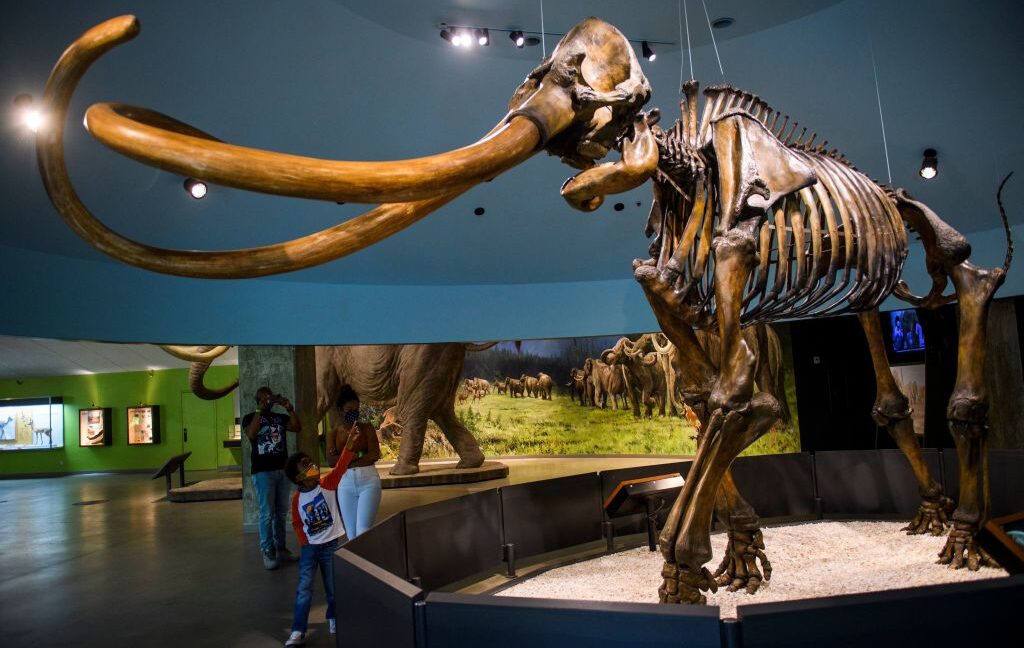Science
Genetic Study Reveals Unexpected Insights into Columbian Mammoths

A groundbreaking study has unveiled surprising genetic findings regarding the Columbian mammoth, suggesting that this iconic species may not be as distinct as previously thought. Researchers successfully extracted genetic information from mammoth remains found in the Basin of Mexico, revealing that these ancient creatures form a unique genetic cluster, different from both the woolly mammoth and other Columbian mammoths.
Historically, mammoths have been categorized primarily as large, hairy elephants, but recent insights indicate a more complex evolutionary background. Among the mammoth species were the Eurasian steppe mammoth, adapted to temperate climates, and the woolly mammoth, which thrived in Arctic conditions. The Columbian mammoth, on the other hand, roamed areas as far south as Central America, a region where DNA preservation has traditionally posed challenges due to warmer climates.
Researchers faced significant obstacles in retrieving ancient DNA, as it typically degrades in hotter environments. Nevertheless, the research team, consisting of Mexican and European scientists, capitalized on the discovery of numerous mammoth bones during construction projects in Mexico City. Notably, over 100 individual mammoths were uncovered during the development of the city’s international airport.
In their study, the team focused exclusively on the mitochondrial genome, which is inherited maternally and often has more surviving copies compared to nuclear DNA. From a total of 83 samples tested, researchers successfully obtained 61 new mitochondrial genomes, with 28 of sufficient quality for analysis. This genetic data allowed them to construct a family tree, uncovering unusual relationships among different mammoth populations.
The results were striking. The genetic data indicated that all the Columbian mammoths from Mexico clustered together, yet their relationship with other species was perplexing. Some Columbian mammoths from northern regions were found to be genetically closer to the woolly mammoth than to their Mexican counterparts. This suggests that mitochondrial DNA may be more influenced by geographic proximity than by species classification.
The researchers proposed two possible explanations for these findings. One theory posits that the Columbian mammoth resulted from multiple hybridization events across various locations, leading to isolated populations. This would imply that the Columbian mammoth is less a single species and more a collection of hybrid populations that developed independently over time.
The alternative explanation, which the researchers favor, suggests that the North American woolly mammoth population possessed diverse mitochondrial lineages before hybridization events occurred. If these hybridization events involved sufficient numbers of individuals, some lineages would have integrated into the population that gave rise to the Columbian mammoth.
Despite the intriguing revelations, the study noted limitations due to the low success rate of extracting mitochondrial DNA. The genetic landscape of Columbian mammoths remains partially obscured, and further exploration of populations further north, where DNA preservation is more likely, is necessary to gain a clearer understanding.
The study, published in the journal Science in 2025, emphasizes the complexity of mammoth genetics and highlights the significance of geographic factors in determining genetic relationships among species. As research continues, scientists hope to unravel more about these fascinating creatures that once roamed the Earth.
-

 Lifestyle1 week ago
Lifestyle1 week agoChampions Crowned in Local Golf and Baseball Tournaments
-

 Science2 weeks ago
Science2 weeks agoMicrosoft Confirms U.S. Law Overrules Canadian Data Sovereignty
-

 Education1 week ago
Education1 week agoRed River College Launches New Programs to Address Industry Needs
-

 Technology1 week ago
Technology1 week agoDragon Ball: Sparking! Zero Launching on Switch and Switch 2 This November
-

 Technology2 weeks ago
Technology2 weeks agoWorld of Warcraft Players Buzz Over 19-Quest Bee Challenge
-

 Technology2 weeks ago
Technology2 weeks agoGoogle Pixel 10 Pro Fold Specs Unveiled Ahead of Launch
-

 Science1 week ago
Science1 week agoChina’s Wukong Spacesuit Sets New Standard for AI in Space
-

 Science2 weeks ago
Science2 weeks agoXi Labs Innovates with New AI Operating System Set for 2025 Launch
-

 Science2 weeks ago
Science2 weeks agoTech Innovator Amandipp Singh Transforms Hiring for Disabled
-

 Technology2 weeks ago
Technology2 weeks agoNew IDR01 Smart Ring Offers Advanced Sports Tracking for $169
-

 Health1 week ago
Health1 week agoRideau LRT Station Closed Following Fatal Cardiac Incident
-

 Technology2 weeks ago
Technology2 weeks agoHumanoid Robots Compete in Hilarious Debut Games in Beijing
-

 Health2 weeks ago
Health2 weeks agoB.C. Review Urges Changes in Rare-Disease Drug Funding System
-

 Technology2 weeks ago
Technology2 weeks agoFuture Entertainment Launches DDoD with Gameplay Trailer Showcase
-

 Technology2 weeks ago
Technology2 weeks agoGlobal Launch of Ragnarok M: Classic Set for September 3, 2025
-

 Science2 weeks ago
Science2 weeks agoNew Precision Approach to Treating Depression Tailors Care to Patients
-

 Lifestyle1 week ago
Lifestyle1 week agoVancouver’s Mini Mini Market Showcases Young Creatives
-

 Technology2 weeks ago
Technology2 weeks agoInnovative 140W GaN Travel Adapter Combines Power and Convenience
-

 Business2 weeks ago
Business2 weeks agoNew Estimates Reveal ChatGPT-5 Energy Use Could Soar
-

 Science2 weeks ago
Science2 weeks agoInfrastructure Overhaul Drives AI Integration at JPMorgan Chase
-

 Top Stories2 weeks ago
Top Stories2 weeks agoSurrey Ends Horse Racing at Fraser Downs for Major Redevelopment
-

 Health2 weeks ago
Health2 weeks agoGiant Boba and Unique Treats Take Center Stage at Ottawa’s Newest Bubble Tea Shop
-

 Business1 week ago
Business1 week agoCanadian Stock Index Rises Slightly Amid Mixed U.S. Markets
-

 Technology2 weeks ago
Technology2 weeks agoDiscover the Relaxing Charm of Tiny Bookshop: A Cozy Gaming Escape










